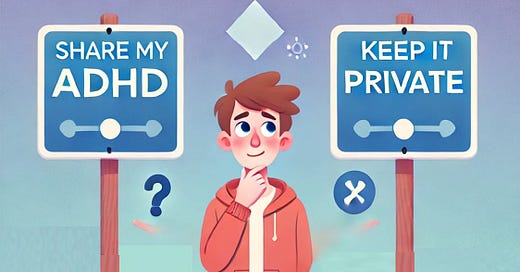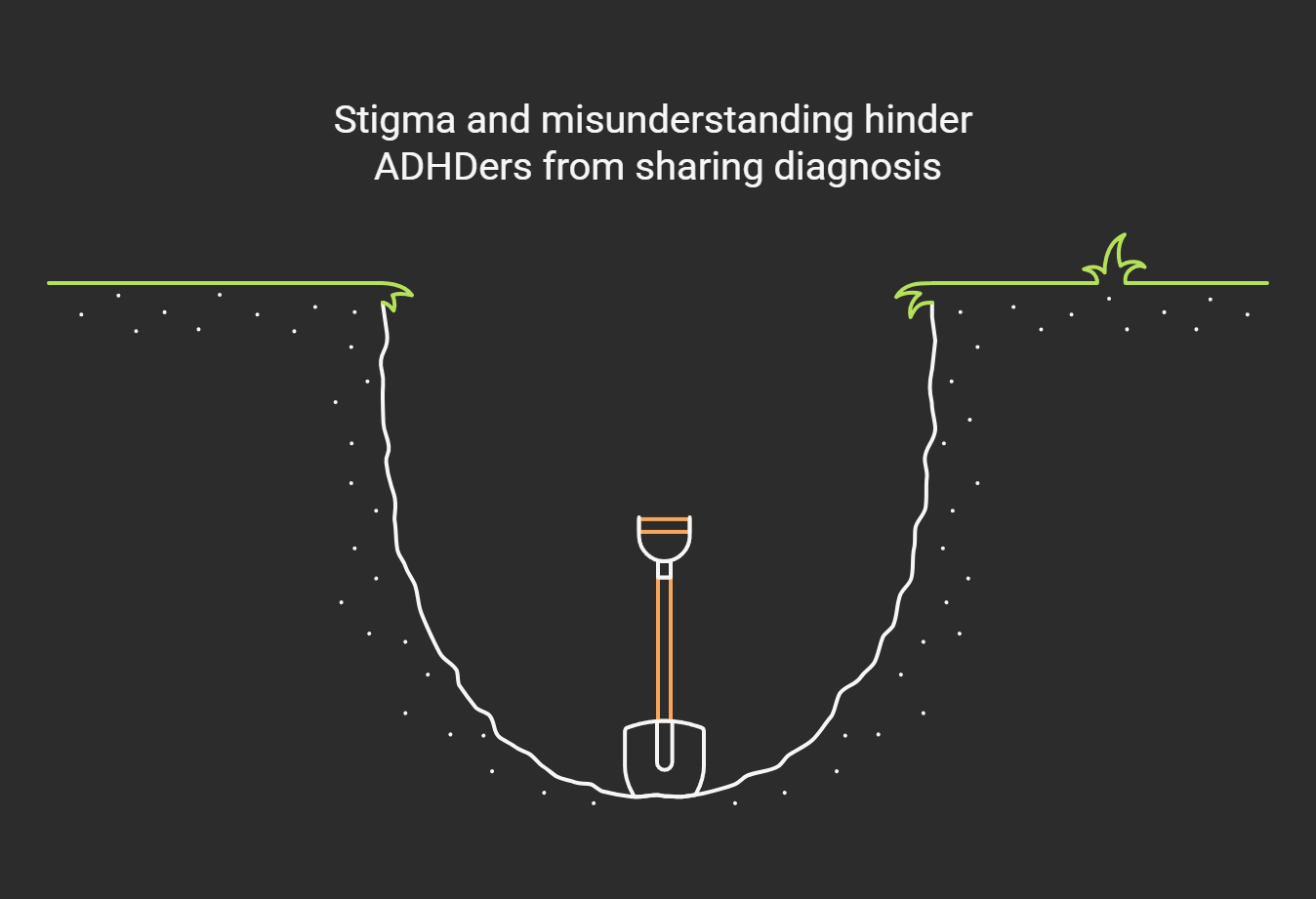🎭 Tell Me you have ADHD without telling me you have ADHD
Reframe Your Traits, boost Your Productivity ⚡ - without saying "ADHD" and stay in Control 🎯
🎭 The Struggle at Work…
You’re in a team meeting. Your boss asks for ideas. You have five, but by the time you organize your thoughts, the topic has changed. Later, someone else suggests the same idea, and everyone loves it.
Or maybe you get feedback like:
🌀 “You have so much energy—slow down.”
📅 “You’re so disorganized, but you always pull it off last minute.”
💡 “You think outside the box, but you need to focus.”
You recognize these ADHD traits. But you’re not comfortable sharing the label—because you’ve seen how people misunderstand it.
So, how do you describe your ADHD strengths and struggles without using the ADHD label?
Let’s dive in! 🚀
🧠 Why Some ADHDers Avoid the Label
Many ADHDers hesitate to share their diagnosis, especially in workplaces or social settings, because:
🚫 Stigma: People assume ADHD = lazy, unreliable, or incapable.
⚖️ Workplace bias: Some managers might see it as a weakness, not a strength.
🛑 Exclusion: Others may treat you differently—either doubting your abilities or over-accommodating.
🔍 Misunderstanding: ADHD is not just about focus—but many people still think it’s just being “distracted.”
Instead of using the ADHD label, you can describe your traits in ways that highlight your strengths and challenges—without the stigma.
🔬 Scientific Backing: Why This Works
📖 Barkley, 2010 – ADHD & Executive Function
Research by Barkley suggests that individuals with ADHD experience challenges in executive function, which impacts planning, impulse control and organizing tasks. ADHD traits often manifest as strengths in specific environments.
Read more: ADHD & Executive Function Overview
📖 Volkow et al., 2009 – Dopamine & Motivation in ADHD
Volkow's research explores how ADHD is linked to lower dopamine activity, influencing motivation, focus, and decision-making. This understanding can explain why individuals with ADHD often have bursts of creativity followed by periods of inertia.
📖 Shaw et al., 2014 – ADHD Brain Structure & Emotional Regulation
Shaw’s study demonstrates that ADHD is associated with specific brain structures and emotional regulation systems, helping to explain emotional sensitivity and the ability to hyperfocus.
📖 Kooij et al., 2019 – ADHD in the Workplace: Challenges & Strategies
Kooij’s research provides insights into how ADHD manifests in the workplace, offering strategies for both employees and employers to foster a supportive environment that leverages ADHD strengths.
⚡ When Does It Strike?
There are moments when ADHD traits become obvious—but how you frame them makes all the difference.
💡 Creative bursts: You have a million ideas, but structuring them is hard.
⏳ Procrastination mode: Deadlines feel impossible—until they’re urgent.
🔄 Hyperfocus vs. boredom: You either forget to eat… or can’t even start.
🗂️ Task-switching struggles: You start five projects at once, then get overwhelmed.
Instead of saying, “I have ADHD, so I struggle with this,” try reframing it in a way that normalizes your experience while keeping the conversation productive.
🎭 Before & After: Reframing ADHD Traits
Here’s how to describe your ADHD traits without using the label (so you don’t get boxed in).
🚀 ENERGY & IDEA GENERATION
❌ “I have ADHD, so my brain jumps around a lot.”
✅ “I thrive in brainstorming sessions - I generate a lot of ideas quickly.”
📅 TIME BLINDNESS & PROCRASTINATION
❌ “I have ADHD, so I’m bad at time management.”
✅ “I work best with clear deadlines and structured priorities.”
🎢 EMOTIONAL INTENSITY & SENSITIVITY
❌ “I have ADHD, so I get overwhelmed easily.”
✅ “I process things deeply and care a lot about getting things right.”
🔄 TASK SWITCHING & FOCUS ISSUES
❌ “I have ADHD, so I can’t focus on one thing at a time.”
✅ “I’m great at handling multiple projects, but I work best with clear priorities.”
This way, you acknowledge your challenges without triggering bias.
🚨 Impact on Daily ADHD Life: With vs. Without the Label
🧠 Without the Label:
✅ Seen as passionate, energetic, and creative.
❌ Misunderstood as disorganized or chaotic.
✅ More control over how people perceive you.
❌ Harder to explain struggles without context.
🎭 With the Label:
✅ Easier to advocate for accommodations.
❌ Risk of being underestimated or judged.
✅ Can find ADHD-friendly tools & support.
❌ Might face bias in professional settings.
There’s no “right” choice - only what works for you.
🛠️ Practical Strategies for Navigating ADHD Without the Label
Here are some practical strategies that can help you navigate life with ADHD, without needing to explain or label your traits:
1️⃣ Set Up External Supports 📌
Use timers, alarms, and checklists to stay on track—without explaining why. Instead of saying, "I forget things easily," just say, "I like to use systems to stay organized."
Tools like Notion, Todoist, or Google Calendar can help structure your workflow without drawing attention.
2️⃣ Own Your Work Style 🎯
If you hyperfocus best at night, say you’re a night owl rather than struggling with a 9-to-5 schedule. If you need movement to think, say you’re a kinetic learner.
Translation: Walking around during calls isn’t weird - it’s productive! 🚶♂️
3️⃣ Create Buffer Time for Tasks ⏳
Since ADHD time blindness makes estimating time tricky, build extra time into your schedule. Instead of saying: "I struggle with deadlines,"
say:"I like to give myself a cushion to ensure high-quality work."
4️⃣ Use Body Doubling Discreetly 👥
Need accountability but don’t want to explain why?
Say, "I work better with a check-in partner" or "I like co-working for focus."
Silent Zoom work sessions or apps like Lifeat.io can help boost productivity without revealing your ADHD.
5️⃣ Lean into Your Strengths 💡
ADHD brains are idea machines. Position yourself as the person who sees innovative solutions. Instead of saying: "I get bored easily," say: "I excel at thinking outside the box."
✅ Action Plan: Communicating ADHD Without the Label
Want to own your ADHD traits while staying in control of the narrative? Try this:
🧠 Step 1: Identify Your Strengths & Struggles
🔹 What ADHD traits show up in your daily life?
🔹 Which strengths help you succeed?
🔹 Which challenges need managing?
🔄 Step 2: Reframe the Narrative
For each struggle, find a neutral or strength-based way to describe it.
📌 Example: Instead of “I get bored easily,” say, “I thrive in dynamic environments.”
⏱️ Step 3: Set Up Systems That Work for You
🔹 Use timers & reminders to manage time blindness.
🔹 Work in structured sprints instead of long work sessions.
🔹 Create visual workflows for organizing tasks.
💬 Step 4: Own Your Communication Style
🔹 Need deadlines? Say: “I do best with clear due dates.”
🔹 Struggle with details? Say: “I work better with bullet points.”
🔹 Hyperfocus? Say: “I dive deep into topics I’m passionate about.”
The key is to stay authentic while shaping the way others perceive your traits.
🎯 ADHD Cheat Sheet:
How to Talk About It Without Saying “ADHD”
⏳ I work best with structure and deadlines (Time blindness & procrastination)
💡 I generate a lot of creative ideas quickly (Fast-thinking, hyperactive mind)
❤️ I process things deeply and care about details (Emotional sensitivity, RSD)
🗂️ I do best with visual organization tools (Executive function challenges)
🚀 I thrive in high-energy, fast-paced environments (Need for stimulation)
This way, you control the conversation- without getting labeled unfairly. 🎯
🚀 Final Thought: Your ADHD, Your Narrative
You don’t have to share your ADHD label if you don’t want to. Your strengths, struggles, and strategies speak for themselves.
🔹 Own your traits.
🔹 Frame them in a way that highlights your value.
🔹 Use systems that support your brain—whether people know you have ADHD or not.
🎯 Try one of these reframing strategies today!
💬 What’s your favorite way to describe an ADHD trait? Drop it in the comments! 👇
📢 Share this with someone who needs it!
👉 Follow or subscribe for more ADHD-friendly tips!









